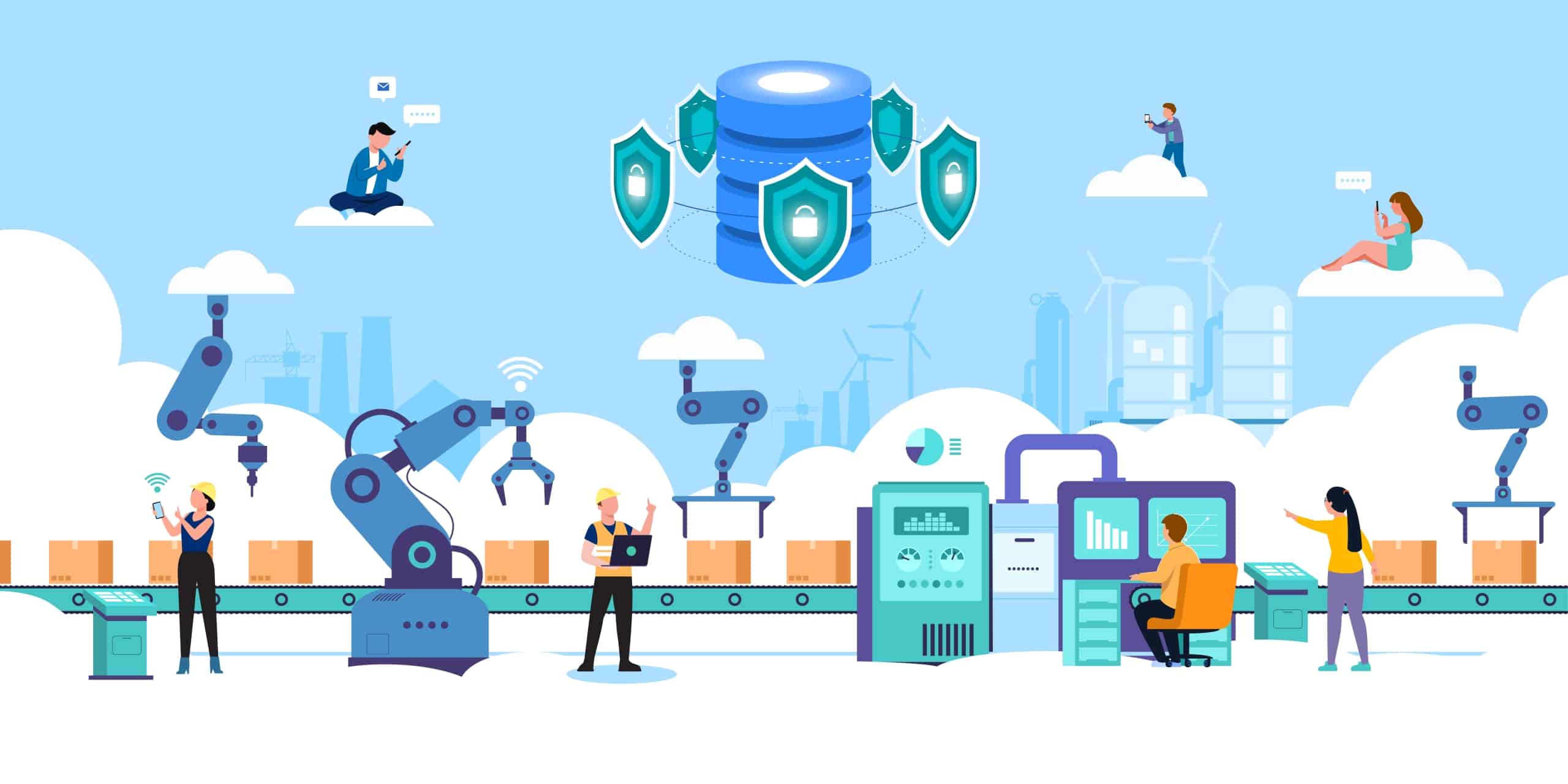1. Smart Energy Management Systems
A key component of contemporary, energy-efficient technology, smart energy management technologies is transforming the way electricity is used in the manufacturing of wet wipes. These systems use smart software, automation, and sophisticated sensors to track and manage energy usage in real time. Smart systems dynamically modify power consumption according to the particular requirements of the manufacturing process, in contrast to traditional machines that run at a fixed energy level regardless of demand. This focused strategy guarantees that energy is used exactly when and where it is required while drastically reducing waste.
For instance, the system minimizes needless electricity use by automatically shutting off non-essential components during idle or low-production periods. On the other hand, it maximizes energy flow during peak activities to guarantee seamless and effective operation without overtaxing the system. By minimizing wear and tear from excessive usage, this flexibility not only reduces energy costs but also increases the lifespan of machines.
Additionally, predictive analytics is frequently included in these systems, offering insights into energy patterns and possible inefficiencies. In order to increase overall efficiency, operators may utilize this data to pinpoint energy-intensive bottlenecks, optimize operations, and make well-informed decisions. Smart energy management systems provide a viable and sustainable way to reach production targets while controlling costs in sectors like wet wipes manufacturing, where operating costs are a major concern.
2. Advanced Heating and Drying Technologies
In the production of wet wipes, heating, and drying are essential steps, but conventional techniques frequently use a lot of energy. Modern heating and drying technologies are revolutionizing the industry by offering precise, focused solutions that significantly increase productivity while using less energy. These cutting-edge solutions guarantee that wet wipes have the ideal moisture content, which is crucial for preserving product quality and satisfying consumer demands.
Infrared (IR) heating is one such method that directs energy onto the things that need to be dried. In contrast to traditional systems that heat the whole manufacturing area, infrared heating targets the moisture in the wipes by emitting certain light wavelengths. Because of its accuracy, less energy is wasted and drying periods are shortened, allowing for quicker production cycles without sacrificing quality.
Ultrasonic drying technology, which extracts moisture from wet wipes using high-frequency sound waves, is another revolutionary development. Compared to conventional drying methods, this approach uses a lot less heat, making it extremely energy-efficient. Ultrasonic drying offers the combined advantages of efficiency and product safety by reducing the possibility of causing damage to delicate materials used in high-end wet wipes while also saving energy.
Furthermore, some devices use hybrid systems, which combine air circulation and warmth to provide balanced drying. By optimizing temperature and airflow, these systems lower the total energy required to provide consistent outcomes. Energy cost reductions for wet wipes manufacturers may be significant, particularly when producing big quantities of wet wipes.
Wet wipes manufacturers may achieve more sustainable production methods and save operating expenses by implementing these cutting-edge heating and drying systems. This is particularly crucial in the current market, where top companies are increasingly differentiating themselves via eco-friendly operations and energy efficiency.
3. Integrated Power Recovery Systems
Wet wipes manufacturers can recycle and reuse energy that would otherwise be squandered thanks to integrated power recovery systems, a stunning advance in energy-efficient technology. These devices transform kinetic energy produced during particular machine operations—like braking or deceleration—into electrical energy that may be used. In addition to minimizing energy waste, this strategy improves overall operational effectiveness, which eventually lowers expenses considerably.
For instance, a wet wipes machine’s high-speed operation produces a significant amount of kinetic energy because of the frequent starting, stopping, and speed changes. Power recovery systems retain this energy and reroute it to power other components of the machine or even feed it back into the grid, preventing it from dissipating as heat. By reducing dependency on outside power sources, this procedure lowers operating expenses and electricity usage.
Furthermore, these systems work especially well in high-capacity production settings where large energy variations are caused by numerous machine cycles. Wet wipes manufacturers can obtain smoother operations and lower energy costs by stabilizing these variations and recycling collected energy. This energy recycling can result in significant long-term savings, particularly for businesses with several units.
The fact that power recovery systems support environmental sustainability is an additional benefit. These technologies contribute to the reduction of industrial processes’ carbon footprint by integrating renewable energy into the production cycle. This improves the brand image of firms that use such technology and is in line with the industry’s rising desire for eco-friendly practices.
In addition to being a progressive approach to cost control, integrating power recovery systems into the manufacturing of wet wipes demonstrates a dedication to sustainability and innovation. Wet wipes manufacturers are better positioned to prosper in a cutthroat, energy-conscious market if they adopt these techniques.
4. Modular Design for Targeted Energy Use
Modern wet wipes equipment’s modular design allows for tailored energy consumption that adjusts to particular production needs, marking a significant advancement in energy-efficient manufacturing. Modular equipment allows operators to activate only the components required for a given operation, rather than powering a whole system throughout each production cycle. Energy usage is significantly decreased by this flexibility, particularly in facilities that produce a variety of product kinds or lower batch sizes.
In a modular system, every module is made to carry out a particular task, such as cutting, folding, or sealing. The remaining modules stay dormant to save needless power consumption when a production run only needs part of these features. With this degree of personalization, wet wipes manufacturers may adjust energy consumption to the precise requirements of the task, guaranteeing effectiveness without sacrificing output quality. A facility that makes travel-sized, compact wet wipes, for example, may utilize fewer modules than one that makes bulk packs, which would result in a proportionate reduction in energy use.
Modular design’s capacity to adjust to changing market demands is another important benefit. Wet wipes manufacturers can add or remove components from their machines to adapt to changing consumer demands without completely redesigning the system. This lowers capital costs on new gear while simultaneously promoting energy efficiency. To further increase savings, modular designs frequently incorporate energy-efficient parts like sophisticated control systems and low-power motors.
The advantages go beyond energy consumption. Since individual modules may be changed or repaired without stopping the entire line, modular machines are usually easier to maintain and repair. By doing this, downtime is reduced and appropriate energy use is maintained throughout operations. Additionally, before implementing energy-saving improvements across the wet wipes manufacturing line, wet wipes manufacturers may test and execute them on a smaller scale thanks to modularity.
Wet wipes manufacturers can attain a sustainable balance between operational expenses and manufacturing efficiency by using modular designs. Modular machinery is a wise, future-ready investment since it not only helps save energy but also puts businesses in a position to react swiftly to shifts in demand.
5. Real-Time Monitoring and Predictive Maintenance
Wet wipes manufacturers are changing how they control energy use and equipment performance using real-time monitoring and predictive maintenance. These technologies offer ongoing insights into machine operations through the use of sophisticated sensors, IoT (Internet of Things) connections, and data analytics. Wet wipes manufacturers can maximize energy utilization and reduce unplanned downtime by spotting inefficiencies and possible problems early on, which can save a lot of money and increase production.
Real-Time Monitoring
Key performance indicators including motor efficiency, temperature, and energy consumption are regularly monitored by real-time monitoring systems. Operators can quickly identify energy-draining processes or underperforming components thanks to the data’s easy-to-use dashboard display. For example, the system notifies the operator if a machine component starts using more power than normal, allowing for prompt remedial action. In addition to saving energy, this proactive strategy stops further equipment wear and tear.
Additionally, these systems provide energy benchmarking, which allows operators to compare the energy consumption of various equipment or production cycles. Wet wipes manufacturers might find trends and use focused tactics to increase efficiency by examining these standards. Operators may find, for instance, that operating specific manufacturing lines during off-peak energy hours might result in cost savings without compromising productivity.
Predictive Maintenance
By anticipating possible mechanical problems before they result in interruptions, predictive maintenance goes beyond energy saving. These systems examine both historical and current data using artificial intelligence (AI) and machine learning algorithms to forecast when a component is likely to fail. Wet wipes manufacturers can prevent unexpected malfunctions that frequently cause energy spikes and operational delays by planning maintenance.
For instance, the predictive system can plan a replacement within a scheduled maintenance window if it determines that a motor is approaching the end of its ideal performance life. This guarantees that the machine will continue to run effectively and prevents the excessive energy consumption that frequently occurs when parts fail. Additionally, predictive maintenance lessens the need for emergency repairs, which can be expensive and energy-intensive to restart and stabilize operations.
Benefits of Synergy
The production line’s overall energy efficiency is increased by the synergistic impact of predictive maintenance and real-time monitoring. Predictive insights guarantee that the machinery is constantly running at maximum efficiency, while real-time data allows for quick modifications to reduce energy loss. When combined, these technologies greatly reduce energy costs while assisting firms in maintaining constant production quality.
Wet wipes manufacturers can gain a long-term competitive edge by incorporating predictive maintenance and real-time monitoring into their operations. These systems are crucial tools for contemporary, cost-conscious production since they not only lower energy usage but also increase equipment life and overall operational efficiency.
6. Transitioning to Renewable Energy Compatibility
Wet wipes equipment’s move toward renewable energy compatibility is a big step toward bringing manufacturing methods into line with international environmental objectives. Wet wipes manufacturers may drastically cut their carbon footprint, minimize operating expenses, and lessen their reliance on traditional electrical networks by incorporating renewable energy sources like solar, wind, or hydropower. This shift is a calculated action that enhances the company’s financial performance and reputation, in addition to being an environmental need.
More and more contemporary wet wipers are made to integrate easily with renewable energy sources. Even with the unpredictable energy supply frequently associated with renewable sources, machinery can function efficiently because of features like energy-efficient motors, flexible power systems, and smart controllers. Machines that include energy storage devices, such as capacitors or battery backups, for example, may store extra solar energy produced during the hottest parts of the day and use it later in production cycles.
Furthermore, these devices frequently include adjustable power input settings that let them alternate between conventional and renewable energy sources as needed. This hybrid capability maximizes the use of greener energy sources while guaranteeing continuous operations.
Over time, switching to renewable energy sources can result in considerable cost savings. Even while renewable energy systems might be expensive to set up initially, the long-term advantages greatly exceed the cost. For example, once erected, solar panels or wind turbines give free energy, significantly lowering monthly power expenditures. Wet wipes manufacturers maximize their savings by maximizing the use of renewable electricity throughout the production process when they combine these systems with energy-efficient wet wipes machines.
Additionally, governments and organizations across the world provide grants, tax breaks, or subsidies to companies that invest in renewable energy. Wet wipes manufacturers of wet wipes may increase their profitability and help create a more sustainable future by utilizing these initiatives to offset installation expenses.
Using renewable energy in manufacturing improves a company’s reputation while also lowering operating expenses. Eco-conscious firms are becoming more and more popular with consumers, and showcasing a dedication to renewable energy may be a potent marketing strategy. Wet wipes manufacturers who promote their usage of green energy have an advantage when trying to attract eco-conscious consumers, merchants, and business associates.
Compatibility with renewable energy also helps firms meet the increasing demand for sustainable supply chains. The adoption of renewable energy enhances a company’s standing as a preferred partner, and retailers frequently give preference to suppliers that follow eco-friendly practices.
Making the switch to renewable energy also offers protection from the fluctuations of traditional energy markets. Because of supply chain interruptions, market demand, or geopolitical conflicts, the price of fossil fuels might change significantly. In contrast, the long-term costs of renewable energy are steady and predictable, giving wet wipes manufacturers financial stability. Better budget planning is made possible by this steadiness, which also lowers the financial risks associated with energy market volatility.
Compatibility with renewable energy is not a one-size-fits-all problem. Depending on their production needs, wet wipes manufacturers may scale their renewable energy systems. Larger manufacturers can investigate on-site wind farms or hydropower projects, whereas medium-sized businesses are best served by smaller configurations, including solar panels on factory rooftops. Because of its scalability, renewable energy solutions continue to be affordable and useful for companies of all kinds.
More than just a fad, switching to renewable energy compatibility is a calculated decision that will help wet wipes manufacturers in real ways. Renewable energy integration is setting the stage for a sustainable and lucrative future in the sector, with benefits ranging from reduced costs and environmental impact to improved brand value and competitiveness in the market. Wet wipes manufacturers establish themselves as leaders in innovation and responsibility, prepared to meet the needs of a greener future, by investing in equipment built to optimize the efficiency of renewable energy.
7. Reduced Heat and Noise Emissions
Modern wet wipes equipment with lower heat and noise emissions improves worker conditions and saves energy, which helps wet wipes manufacturers overcome major obstacles. In addition to using more energy for cooling and noise control, traditional machinery frequently produces excessive heat and noise, making the workplace unpleasant and sometimes dangerous. Through creative engineering and state-of-the-art technology, advanced wet wipes machines are made to reduce these emissions, offering several advantages beyond energy savings.
The adoption of better insulating materials and energy-efficient motors that produce less heat when operating are two notable advancements. Conventional motors and parts tend to overheat, necessitating the use of energy-intensive supplementary cooling devices. On the other hand, contemporary devices use sophisticated cooling systems and heat-dissipating materials, which lessens the need for external cooling systems that consume a lot of energy. This guarantees that machines may run over extended periods without experiencing performance problems, which directly lowers power usage and operating expenses.
Another crucial area where sophisticated wet wipes equipment shines is noise reduction. Conventional equipment frequently uses antiquated mechanical systems that generate loud noises, which can cause discomfort for workers and perhaps harm their hearing over time. Operating noise is greatly decreased by the sound-dampening technology included in modern machines, such as vibration-isolating parts and quieter motor designs. In addition to making the workplace safer and more comfortable, these upgrades also remove the need for extra noise-canceling techniques like soundproofing or earplugs, which lowers costs even further.
Reducing noise and heat emissions also increases the robustness and effectiveness of wet wipes machines. Overheating can hasten component wear and tear, necessitating more frequent maintenance and increased energy use because of reduced efficiency. In a similar vein, vibrations that produce noise can lead to mechanical stress, which shortens the lifespan of important components. By resolving these problems, contemporary machinery continues to operate at peak efficiency for extended periods, guaranteeing more seamless operations and less downtime.
Reduced heat and noise emissions provide operational advantages as well as compliance with regulations and environmental objectives. Adopting equipment that satisfies the strict environmental and worker safety regulations in many nations may establish firms as leaders in the sector dedicated to ethical business practices. Furthermore, by lessening the environmental damage and noise pollution brought on by industrial operations, lower emissions enhance bonds with nearby communities.
Wet wipes manufacturers may save energy costs, improve worker safety, maintain regulatory compliance, and encourage sustainable practices by investing in wet wipes machines that emit less heat and noise. These developments show a progressive approach to manufacturing and provide observable advantages that support efficiency and long-term success.
8. Customizable Production Cycles for Energy Optimization
Modern wet wipes equipment has a strong feature called adjustable production cycles that lets wet wipes manufacturers maximize energy use without sacrificing output. Conventional production systems frequently use the same amount of energy for all tasks and run at set rates and outputs. This lack of adaptability leads to wasteful energy use, especially during specialized or low-demand manufacturing runs. On the other hand, operators may modify machine settings to meet particular production needs thanks to adjustable production cycles, which guarantee effective and economical use of energy.
The flexibility to increase operations in response to demand is one of the main advantages of customized production cycles. For example, machines can run at full capacity and produce their greatest amount of work during times of high demand. However, production cycles can be modified to operate at lesser rates or capacities during slower times or when creating specialty items in smaller quantities. This flexibility reduces energy usage without sacrificing the final product’s quality or consistency.
Wet wipes manufacturers may also optimize energy use by scheduling energy-intensive jobs during off-peak hours, when utility prices are cheaper, thanks to customizable cycles. For instance, energy-intensive procedures like drying and sealing might be scheduled to take place during these economic times. This lowers operating costs and helps balance energy loads, avoiding power use spikes that can put a burden on nearby grids or result in extra fees.
Customizable cycles also enable the creation of a wide range of product lines with different requirements. Certain wet wipes could need different amounts of wetness, folding styles, or packing forms, all of which call for different machine settings. Wet wipes manufacturers may prevent resource overuse and guarantee that energy is distributed exactly where it is required by adjusting production cycles to meet these needs. Businesses that target specialized audiences or provide limited-edition items would particularly benefit from this degree of accuracy.
Customizable manufacturing cycles become even more efficient with the inclusion of smart controls and IoT technology. Operators may monitor and adjust cycles for maximum performance using real-time sensor data, preventing energy loss from inefficient settings or duplicate procedures. Additionally, sophisticated software may automate changes according to preset parameters, removing the need for ongoing manual supervision and lowering the possibility of human mistakes.
The lifespan of machinery is also influenced by customizable manufacturing cycles. Component wear and tear is reduced by running machines at ideal settings catered to certain jobs, which lessens the need for regular maintenance and replacements. This guarantees steady performance and dependability throughout the machine’s life, in addition to reducing maintenance expenses.
Customizable production cycles enable companies to increase energy efficiency, cut expenses, and quickly adjust to changing market needs in the wet wipes manufacturing process. For wet wipes manufacturers looking to increase revenue while upholding a commitment to ecologically conscious practices, this invention offers a workable and sustainable answer.









